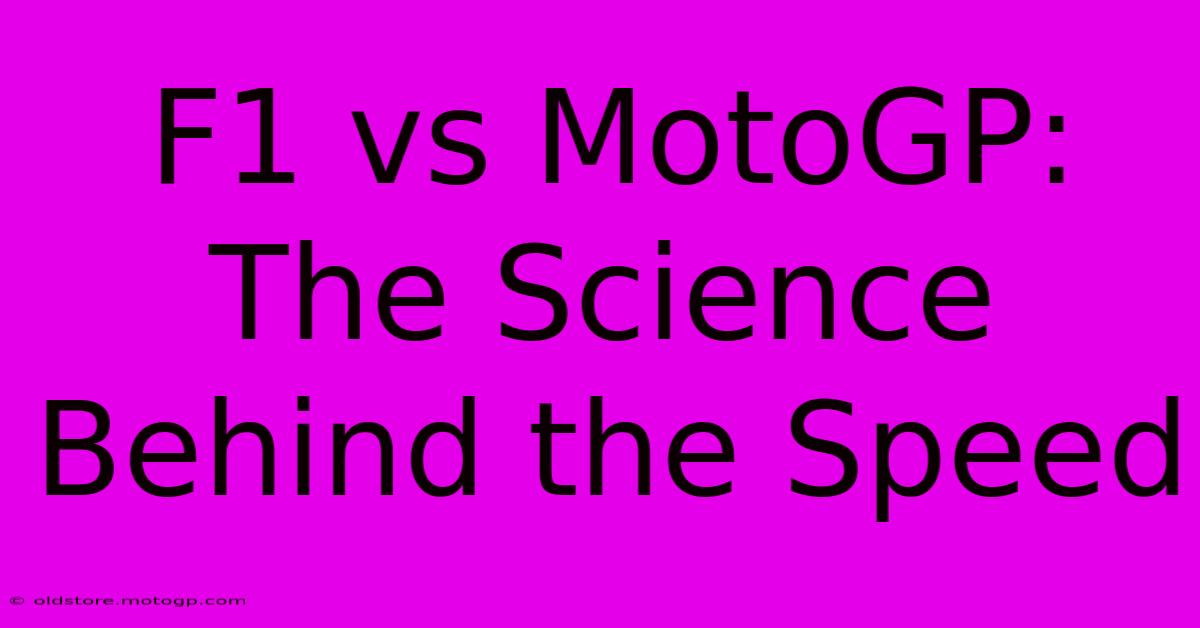F1 Vs MotoGP: The Science Behind The Speed

Table of Contents
F1 vs MotoGP: The Science Behind the Speed
For motorsports enthusiasts, the debate is eternal: Formula 1 or MotoGP? Both offer breathtaking speeds, incredible skill, and technological marvels, but the science behind their velocity is distinctly different. This article dives deep into the physics and engineering that propel these machines to their respective limits, exploring why comparing them directly is like comparing apples and oranges – both delicious, but fundamentally different.
The Physics of Downforce: A Key Differentiator
One of the most significant differences lies in how each utilizes downforce. Formula 1 cars are masters of aerodynamic grip. Their complex designs, featuring intricate wings, diffusers, and ground effect tunnels, generate immense downforce, pressing the car onto the track. This allows for incredibly high cornering speeds, as the car is literally glued to the tarmac.
MotoGP bikes, on the other hand, rely on a much more delicate balance. While they do benefit from some aerodynamic elements – such as winglets and fairings – their downforce is significantly less than an F1 car. The primary source of grip comes from the tires’ contact patch with the road. This means MotoGP riders must rely heavily on their skill and the bike's chassis to manage the forces at play, especially during lean angles in corners.
Aerodynamics: A Tale of Two Approaches
F1's aerodynamic sophistication is legendary. Teams employ computational fluid dynamics (CFD) extensively to design and optimize every aerodynamic component. The goal is to maximize downforce while minimizing drag – the resistance to movement through the air. Every millimeter counts in the quest for that perfect balance.
MotoGP bikes, while possessing aerodynamic elements, prioritize a different approach. Reducing drag becomes crucial at high speeds, as any unnecessary resistance can significantly hamper top speed. Aerodynamic developments focus on streamlining the bike and rider to minimize air resistance, enhancing straight-line speed.
Engine Technology: Power and Revolution
The power plants powering these machines are equally fascinating. F1 cars utilize highly advanced, complex hybrid power units, combining internal combustion engines (ICE) with electric motors. This combination allows for both immense power and energy recovery systems, improving efficiency and lap times. The sophisticated engine management systems are constantly optimizing fuel delivery and power output.
MotoGP bikes feature powerful, high-revving inline engines. These engines typically have a much higher redline than F1 engines, offering explosive acceleration and a thrilling power delivery. The focus here is on maximizing horsepower and torque for rapid acceleration and overtaking capabilities. The reliance on the engine's raw power dictates a very different approach to chassis design compared to the downforce-focused F1 cars.
Tire Technology: Grip and Traction
The tires play a pivotal role in both F1 and MotoGP. F1 cars use slick tires, offering maximum grip on dry tracks. Tire degradation and strategy are critical aspects of race management. The development of these tires is an ongoing arms race between tire manufacturers and teams, pushing the boundaries of grip and performance.
MotoGP bikes employ tires with grooved patterns for wet and dry conditions, balancing grip and water dispersal. Tire wear and temperature management are crucial factors for riders to maintain consistency and prevent crashes. The immense lean angles in MotoGP put significant stress on the tire contact patches, requiring specialized tire construction and compounds.
The Rider Factor: Human Element vs Machine
While the technology is crucial, the human element is paramount. F1 drivers operate complex machines requiring precision and stamina, managing energy deployment and tire wear. Their skill lies in seamlessly integrating with the sophisticated car systems.
MotoGP riders, on the other hand, have an even more intimate connection with their machines, directly experiencing the physical forces of acceleration, braking, and lean. They must demonstrate exceptional balance, reflexes, and physical fitness to handle the intense physical demands of the sport.
Conclusion: A Matter of Perspective
F1 and MotoGP represent distinct approaches to high-speed motorsport. F1 prioritizes aerodynamic grip and sophisticated hybrid technology, creating cars that are essentially aerodynamic marvels capable of immense cornering speed. MotoGP emphasizes raw engine power, tire grip, and rider skill to achieve breathtaking acceleration and thrilling cornering precision. Ultimately, the “better” discipline is a matter of personal preference – both are magnificent testaments to human ingenuity and athleticism.

Thank you for visiting our website wich cover about F1 Vs MotoGP: The Science Behind The Speed. We hope the information provided has been useful to you. Feel free to contact us if you have any questions or need further assistance. See you next time and dont miss to bookmark.
Featured Posts
-
Yamahas Moto Gp Development Program
Feb 21, 2025
-
Innovation Unleashed The Sting In Formula 1 Design
Feb 21, 2025
-
The Moto Gp Goat Skill Strategy And Success
Feb 21, 2025
-
Racing Motor Bikes For Sale Ride The Edge
Feb 21, 2025
-
Cota Open Track Days The Perfect Birthday Gift
Feb 21, 2025
